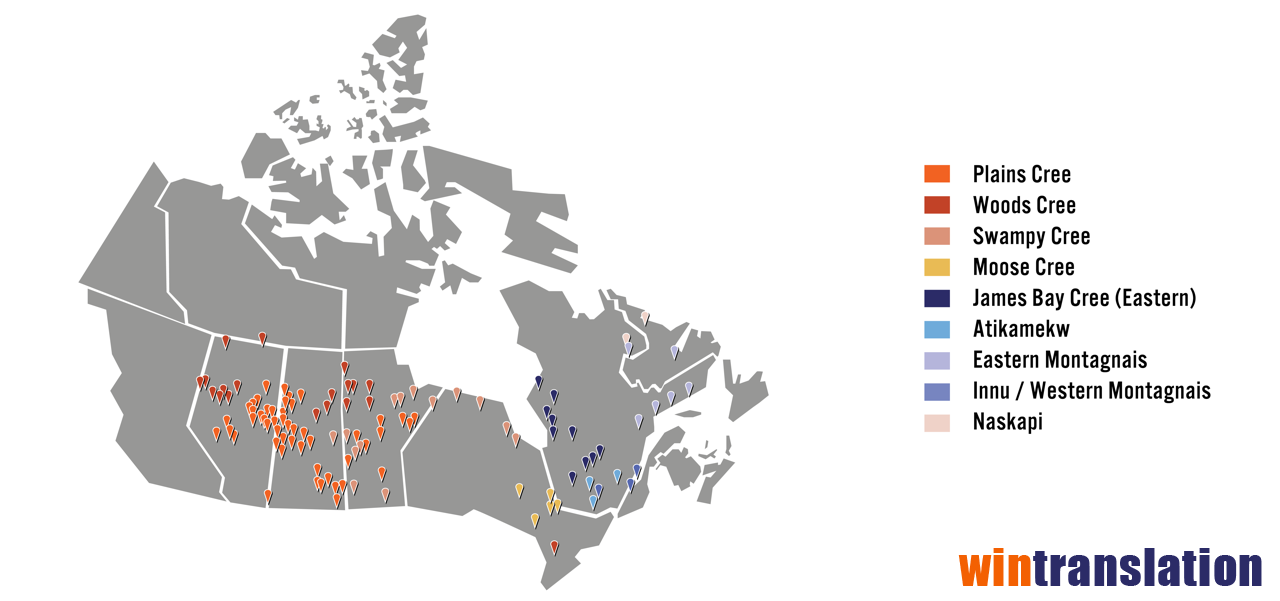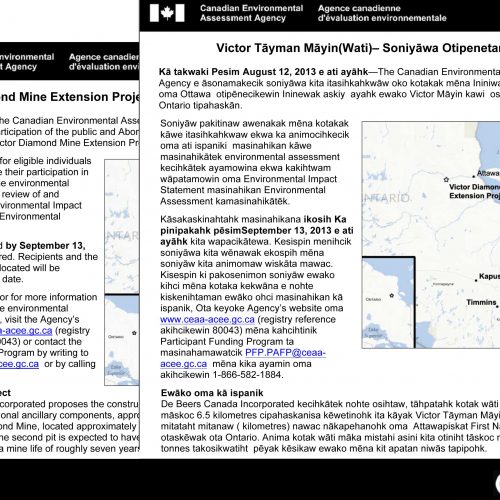Professional Swampy Cree Translation Services
Cree is the most widely spoken Indigenous language in Canada, however it also has a wide variety of different dialects which distinguish them from each other. Many clients come to us looking for Cree translation services, but in reality they need a specific dialect that is unique to their target region. Swampy Cree is one of those dialects we routinely translate to and from, and it is spoken mainly in Northern Manitoba, Northwest Saskatchewan and the coast of the Hudson and James Bay areas.
Summary of Qualifications for wintranslation's Swampy Cree Translators
Annie M.
- Fluent in the Swampy Cree dialect, having spoken the language her entire life
- Over 15 years of experience as an interpreter and translator for English into Cree languages
- Active First Nations member who has taught the Swampy Cree language
Darren O.
- Holds a degree from the University of Regina in Indian Education and Language Arts as well as in Cree Linguistics
- Fluent in the Plains Cree dialect and has been involved in creating a Cree curriculum for schools in Saskatchewan
- Has 20 years of experience in the field of education, specializing in Cree language subjects
Cree & Swampy Cree Translation Portfolio

This particular dialect of Cree is the most most widely spoken Cree dialect. It is spoken mainly in the regions of Alberta and Saskatchewan, but there are also a number of Plains Cree speakers in British Columbia and the Northwest Territories. Plains Cree is also known as the “y” dialect.
Communities where Plains Cree is commonly spoken:
- Cowessess First Nation
- Little Black Bear First Nation
- Muscowpetung First Nation (also Western Ojibway)
- Nekaneet First Nation
- Ochapowace First Nation
- One Arrow First Nation
- Peepeekisis First Nation
- Star Blanket First Nation
- Ocean Man First Nation (also Assiniboine and Western Ojibway)
- Pheasant Rump Nakota Nation (also Stoney and Western Ojibway)
- Whitebear First Nation
- Kahkewistahaw First Nation
- Okanese First Nation (also Western Ojibway)
- Pasqua First Nation (also Western Ojibway)
- Sakimay First Nation (also Western Ojibway)
- Daystar First Nation
- Gordon First Nation (also Western Ojibway and Metis)
- Kawacatoose First Nation
- Muskowekwan First Nation
- Piapot First Nation
- Beaver Lake Cree Nation
- Big Island Lake First Nation (also known as Joseph Bighead First Nation)
- Frog Lake First Nation
- Kehewin Cree Nation
- Lucky Man First Nation
- Moosomin First Nation
- Mosquito-Grizzly Bear’s Head-Lean Man (also Stoney)
- Muskeg Lake First Nation
- Pelican Lake First Nation
- Muskoday First Nation
- Peguis First Nation
- Sturgeon Lake First Nation
- Thunderchild First Nation
- Waterhen Lake First Nation
- Witchekan Lake First Nation
- Alexander First Nation (also Wapski Mahikan Society)
- Alexis Nakota First Nation (also Stoney)
- Enoch Cree Nation
- Ermineskin Cree Nation (also Stoney)
- Louis Bull First Nation
- Montana First Nation
- O’Chiese First Nation (also Western Ojibway)
- Onion Lake Cree Nation
- Papaschase First Nation
- Paul First Nation (also Stoney)
- Saddle Lake Cree Nation
- Whitefish (Goodfish) Lake First Nation
- Samson Cree Nation
- Sunchild First Nation
- Ahtahkakoop First Nation
- Mistawasis First Nation
- Beardy’s and Okemasis First Nations
- James Smith First Nation
- Little Pine First Nation
- Poundmaker First Nation
- Red Pheasant First Nation
- Sweetgrass First Nation
- Big River First Nation
- Canoe Lake First Nation (also Woods Cree)
- Flying Dust First Nation
- Island Lake First Nation
- Makwa Sahgaiehcan First Nation
The Woods Cree dialect is spoken in the northern regions of Manitoba and Saskatchewan. It is also known as the “th” dialect of the Cree language.
Communities where Woods Cree is commonly spoken:
- Barren Lands First Nation
- Bunibonibee Cree Nation
- Chemawawin Cree Nation (also Swampy Cree)
- God’s Lake First Nation
- Lac La Ronge First Nation
- Peter Ballantyne Cree Nation
- Montreal Lake First Nation
- Manto Sipi Cree Nation
- Marcel Colomb First Nation
- Black Sturgeon First Nation
- Mathias Colomb First Nation
- Misipawistik Cree Nation (also Swampy Cree)
- Moose Lake First Nation
- Nisichawayasihk Cree Nation
- O-Pipon-Na-Piwin Cree Nation
- Norway House Cree Nation
- Opaskwayak Cree Nation (also Swampy Cree)
- Cross Lake First Nation
- Tataskweyak Cree Nation
- Bigstone Cree Nation
- Cross Lake First Nation
- Canoe Lake First Nation
- Driftpile First Nation
- Duncan’s First Nation
- Fort McMurray First Nation (also Dene/Chipewyan)
- Heart Lake First Nation
- Kapawe’no First Nation
- Little Red River Cree Nation
- Loon River First Nation
- Lubicon Lake Indian Nation
- Mikisew Cree First Nation
- Red Earth Cree Nation (also Swampy Cree)
- Sawridge First Nation
- Shoal Lake Cree Nation (also Swampy Cree)
- Sturgeon Lake Cree Nation
- Sucker Creek First Nation
- Swan River First Nation
- Whitefish Lake First Nation
Spoken mainly in communities in the northern Manitoba, northwest Saskatchewan and the coast of the Hudson and James Bay in northern Ontario, Swampy Cree is also known as the “n” dialect of the Cree language.
Communities where Swampy Cree is commonly spoken:
- Attawapiskat First Nation
- Chemawawin Cree Nation (also Rocky Cree)
- Cumberland House Cree Nation
- Fisher River Cree Nation
- Fort Albany First Nation
- Fort Severn First Nation
- Fox Lake Cree Nation
- Kashechewan First Nation (also Moose Cree)
- Misipawistik Cree Nation (also Rocky Cree)
- Mosakahiken Cree Nation
- Opaskwayak Cree Nation (also Rocky Cree)
- Red Earth Cree Nation (also Woods Cree)
- Sapotaweyak Cree Nation
- Shamattawa Cree Nation
- Shoal Lake Cree Nation (also Woods Cree)
- Tataskweyak Cree Nation
- War Lake First Nation
- Weenusk First Nation
- Wuskwi Sipihk First Nation
- York Factory First Nation
Spoken only in Ontario in an area that ranges from James Bay to Lake Superior, Moose Cree is also known as the “l” dialect of the Cree language.
Communities where Moose Cree is commonly spoken:
Spoken only in Quebec in an area that ranges from the east coast of lower Hudson Bay and James Bay, and inland southeastward, James Bay Cree is also known as Southern and Northern East Cree.
Communities where James Bay Cree is spoken:
- Chisasibi
- Eastmain
- Mistissini
- Nemaska
- Oujé-Bougoumou
- Waskaganish
- Waswanipi
- Wemindji
- Whapmagoostui
- Washaw Sibi
Spoken in southwestern Quebec, Atikamekw is spoken by nearly all the Atikamekw and is among the most widely spoken Indigenous languages in Canada.
Communities where Atikamekw is commonly spoken:
- Atikamekw d’Opitciwan
- Les Atikamekw de Manawan
- Conseil des Atikamekw de Wemotaci
Spoken in eastern Quebec and Labrador, Eastern Montagnais has various dialects depending on the community.
Communities where Eastern Montagnais is commonly spoken:
- Mingan
- Uashat-Maliotenam
- Matimekosh
- Natashquan
- Pakua-Shipi
- La Romaine
- Sheshatshiu
Spoken in southeastern Quebec, Western Montagnais has various dialects depending on the community.
Communities where Western Montagnais is commonly spoken:
- Mashteuiatsh
- Betsiamites
- Essipit
Spoken in northeastern Quebec and Labrador, Naskapi some times uses Eastern Cree syllabics and share many linguistic features of East Cree.
Communities where Naskapi is commonly spoken:
- Kawawachikamach
- Natuashish
Choose wintranslation
An award-winning translation service provider based in North America, wintranslation has a fifteen year track record in managing complex multimedia and large-scale projects on time and on budget. Our company specializes in the translation of Canada’s Indigenous languages including Inuktitut, Inuinnaqtun, Malecite and Ojibwe. Please see our languages page for a full list of languages.
WE WOULD LOVE TO HELP WITH YOUR NEXT CREE PROJECT
GET A FREE QUOTE NOW
Related Services
Kutenai Translation Services
Kutenai or Kootenay, as it's spelled in Canada, (Kootenai in the United States), is also known as Ktunaxa. It is…
Innu-aimun Translation Services
Innu-aimun, also known as Montagnais, is an Algonquian language spoken by more than 10,000 Innu people across Labrador and Quebec…
Thompson Translation Services
Thompson, more accurately known as Nlaka'pamuctsin or Nlaka'pamux, is part of the Interior Salish language family and spoken in Fraser…

